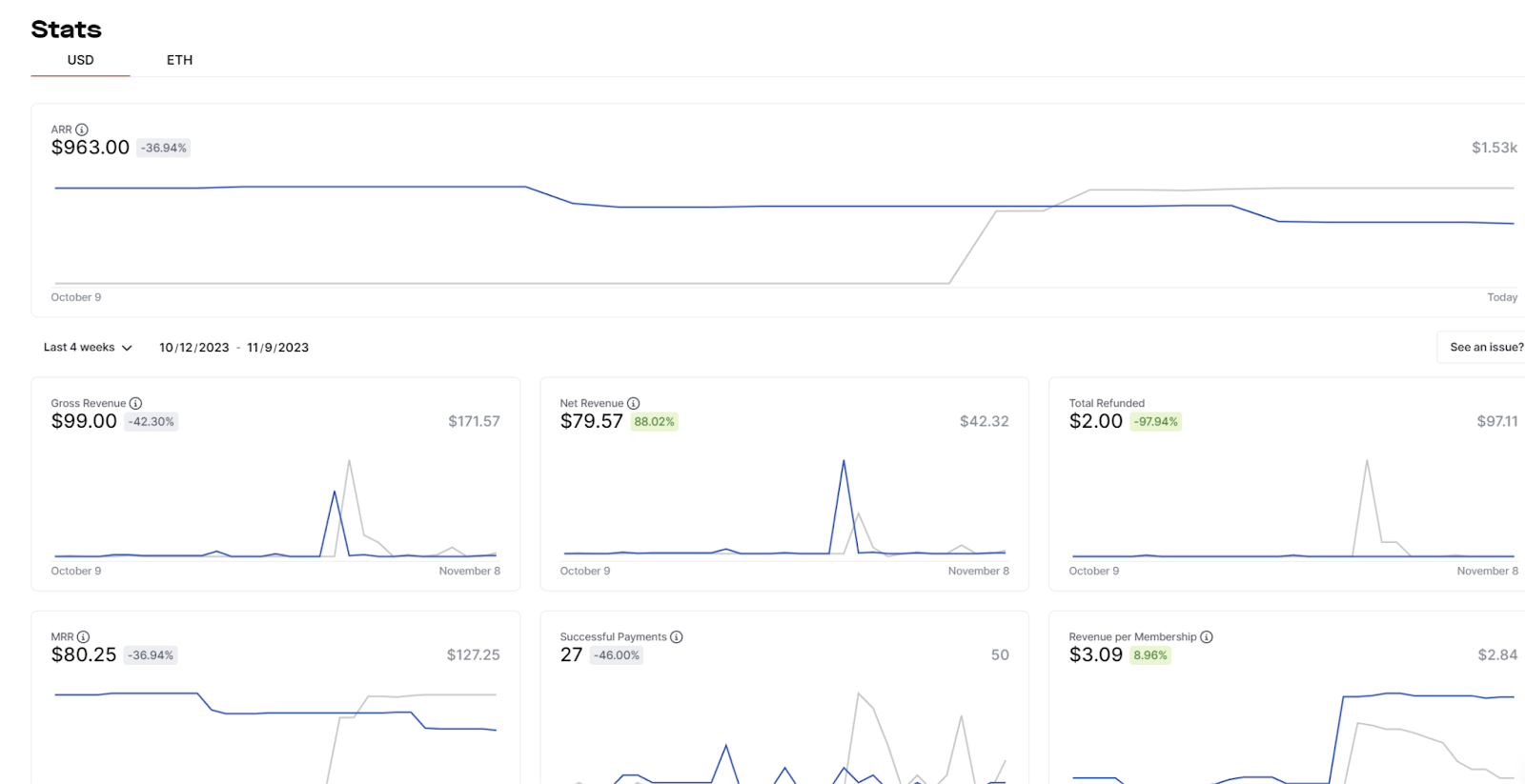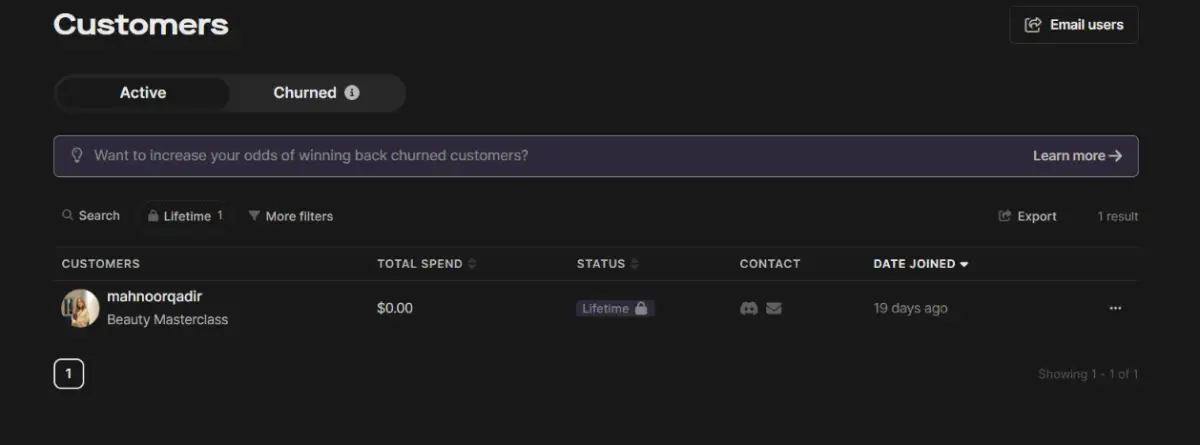For business owners, product development and marketing come first. Then, the next priority should always be focusing on business statistics. These statistics will give them insights, in turn helping them to improve the bottom line of their business. One such example of said statistics is 'product adoption metrics'.
Unfortunately, as sales begin and continue, many businesses focus too much on pure sales data, which can negatively impact their understanding of actual customer adoption behavior. Rather than focusing on sales data, businesses should turn their attention to product adoption metrics, in order to get a more accurate and insightful overview of how their business is doing.
If you're a business owner wondering 'What are production adoption metrics?', don't fret! Whop is here to answer that question and many more.
To help establish an ideal method for prioritizing and measuring product adoption metrics, we have compiled a list of 10 product adoption metrics, including actionable information highlighting the most critical data points with examples and information about what each metric can reveal. Before diving into the exact metrics, let’s go over why they are important to measure and track in the first place.
Why is it Important to Track Product Adoption Metrics?
While sales data, download statistics, and total revenue are significant high-level business metrics to monitor, they only tell a very small story about a product. What they don’t tell you is how new and existing customers are interacting with a product.
For example, businesses can achieve large initial sales and download volumes, only for a product to fizzle out quickly because users are not engaging with it or fully adopting its potential. It’s the common fate of many hyped-up apps that get deleted after just a few days or weeks. At this point, businesses then struggle with understanding where they fell short.
Product adoption metrics can help to bridge that knowledge gap by forcing businesses to actively measure and monitor specific customer behavior. These metrics can demonstrate underlying issues - which can include a lack of interaction or high time to value data. So, rather than wondering why your app has been deleted, you can see the underlying issues and develop a plan to mitigate these.
But what product adoption metrics do you need to be tracking? The difficulty is identifying and prioritizing the most important ones. Here is a list of fifteen worth tracking.
💡 Hot Tip: Whop has a powerful dashboard that displays an array of metrics for all of its sellers. Sign up today and see it for yourself!

15 Product Adoption Metrics To Track
While not all of these metrics will be applicable to every business and product type, the metrics that they measure will help to influence your business decisions in a positive direction.
After this list, we will break down which are most relevant depending on the stage of your business.
#1. Product Adoption Rate
Product adoption rate measures how many customers continue to regularly use a product or service after first signing up.
A great example is Facebook’s parent company, Meta, which released 'Threads' as a Twitter competitor. Within a few days, it hit 44 million active daily users, but plummeted by over 80% within eight weeks, reflecting a drastic drop in adoption metrics.
While product adoption rates often go down in the months after a new release, sudden changes can highlight issues like a marketing campaign that overpromises and underdelivers.
Product Adoption Rate = (new engaged users/total signups) x 100
#2. Free-to-Paid Conversion Rate
The free-to-paid conversion rate is a metric that measures how many free trial customers convert to paying customers after the trial period ends.
Many software and SaaS companies offer a free trial, allowing potential customers to experience a product for a set period, typically from one week to one month, before financially committing. Although it is expected that the conversion rate will never be 100%, monitoring this metric can provide insights into issues like a poor customer understanding of or lack of value, a confusing interface, inadequate or unclear tiered pricing, or trial periods that are too short.
Adjusting these potential issues one at a time to see which impacts this metric the most is good practice to improve paid customer acquisition and retention
Free-to-Paid Conversion Rate = Number of paid sign-ups/Number of free trial users
#3. Activation Rate
The activation rate measures the percentage of users who get to a specific step, or activation point, in a software system.
For example, an email marketing tool might have activation points that include the first email list added, the creation of the first email, the assessment of open rates, and the usage of follow-up email functions.
The activation rate for these critical features provides insights into whether customers are using a system's full potential, which can highlight shortfalls in onboarding and educational tools.
Activation Rate = Number of completed milestones/Number of new users
#4. Time-To-Value
Time-to-value (TTV) is a metric that establishes how long it takes for customers to realize the full value that a product or service provides. It’s the “ah-ha” moment when users understand that the product they bought actually satisfies the problem they were trying to solve.
Returning to our email marketing tool example, setting parameters for TTV could involve measuring how many users set up and monitor new emails weekly or monthly.
This is a crucial metric because a high TTV could indicate usability issues, which would ultimately lead to higher churn rates and loss of customers.
TTV = The amount of time it takes for users to get their first aha moment (could measure this in screens, minutes, clicks, etc.)
#5. Customer Acquisition Cost (CAC)
An important acquisition related metric is the Customer Acquisition Cost, or CAC, which simply refers to how much it costs to get a new customer. This metric becomes especially relevant as you start using ad campaigns, and will help you allocate budget according to whatever the data shows.
Depending on your bankroll and the price of your product, your target customer acquisition cost will vary. You can continue to tweak this metric to fit your business model, but unless you have raised capital and have money to burn, the CAC should be less than the product cost.
CAC = Total marketing and sales costs / Total number of new customers acquired
#6. Retention and Churn Rate
The retention rate is applicable to those who manage a paid membership with monthly recurring revenue, and measures the percentage of customers who renew in a given timeframe, while the churn rate measures the percentage of customers who leave.
Calculating churn rate is fairly simple: for example, a SaaS business with 10,000 active monthly subscribers that loses 50 subscribers each month will result in a churn rate of 0.5%.
It’s a critical data point, as comparing this metric over time can provide early insights into an increasing number of customers leaving due to reasons such as system issues, missing features, or more and better competition.
Churn = (Subs at beginning of the month) - (subs at end of the month) - (customers gained during the month)

Whop’s seller dashboard shows how many active members you have, along with those that have churned.
#7. Customer Lifetime Value (CLV)
CLV measures the total value a business gains from an average customer over the entire lifetime of the relationship and goes far beyond just measuring the value of sales.
For a SaaS business, CLV requires measuring how much the average customer pays on a monthly basis and multiplying that value by the average months that customers remain active.
By regularly calculating this metric, businesses can identify changes in customer behavior regarding their loyalty to a product or service.
CLTV = Average value of customer (monthly or annual basis) X average customer lifespan
#8. Conversion Rate
Conversion rate is perhaps the most common and important metric to measure for a business owner. This metric measures the percentage of customers who make engagements throughout the different steps of a funnel, which generally includes clicks and purchases. A popular example is the conversion rate of social media ads to an e-commerce store. The simplest measure will be the click-through rate, or CTR. When on the sales page, this metric can measure the percentage of people who sign up for a free trial or purchase.
Understanding conversion rates and comparing them to industry standards, while making changes to things like ad copy or CTA placement and design, will allow you to increase the number of customers that end up visiting your site and buying your product or service.
Conversion rate = (conversions/total visitors) x 100
#9. Average Interaction Rate
Interaction rates, aka session rates, measure the average time customers spend using a product or service each time they log in.
An area where this is a commonly measured metric is for business website traffic. Tools like Google Analytics can measure how long website visitors spend browsing and reading pages.
Achieving a high average interaction rate is an indicator of how easy or engaging customers find a service to use, and displays how much value they gain every time they log on or connect.
#10. Average Session Duration
The average time that a customer spends using your product is measured as the Average Session Duration. If you have SaaS that is not a web app, it might be quite difficult to track this metric. Google Analytics will automatically give you this information for any web pages related to your business. The longer the duration is, generally the better your product is and the greater your overall retention is.
If your Average Session Duration is below industry standard, you should make changes, either to your UX/UI or the product functionality.
Average Session Duration = total duration of all sessions/total number of sessions during selected time frame
#11. Active User Metrics (DAU, WAU, MAU)
Once you have reached a certain level of adoption and critical mass, you should pay attention to active user metrics, which are categorized by time period. The most common time frames are Daily Active Users (DAU), Weekly (WAU) or Monthly (MAU). If you have problems with retention and churn rate, you can check to see if your active user related metrics are on the low end compared to the overall percentage of paying customers, which will point to any adjustments that you might need to make to your business or its product.
You can also use these active user metrics to determine how often users return to use your product and how much they are using it when they do so, which is known as “stickiness”.
#12. Usage Frequency
Usage frequency is often measured alongside metrics like average daily/weekly/monthly active users. Its goal is to provide information about how regularly customers use a product or service in a specific time frame.
For a SaaS company offering customer survey tools, this metric would identify how often registered customers log in and send out a new survey.
The value of usage metrics comes from a better understanding of how often different customer groups use certain features. From this, a business owner can deduce shortfalls which can include a lack of customer understanding of all capabilities or it could mean missing product functions or features.
Usage frequency = the number of users who access a product within a certain time period / total number of users
#13. Upsell Rate
Upsell rate tracks conversions, but it goes a step beyond traditional conversion rate metrics. It measures how many customers end up converting when asked to add different products or upgrade to a better and pricier service.
It’s a common metric for ecommerce store owners to use who have a working business model but want to increase revenue and average customer value. For example, SaaS companies almost always offer tiered pricing models where many customers first sign up for the cheapest option.
Once the customer has been using the cheapest product or service for some time, the business will attempt to get them to upgrade their package for more service options, often via email marketing. Tracking the upsell rate can help businesses identify both wins and issues in the tiered product offering or perhaps with their onboarding and training materials.
Upsell rate = # of customers who purchased additional software in a group / total # of customers in that group
#14. Customer Satisfaction (CSAT)
The Customer Satisfaction, or CSAT, is a critical metric that requires interaction to acquire. You can get it by running a survey, either within your product or site, or through email marketing. It is often reported as a single digit score or on a scale of 'Bad' to 'Great'.
Be sure to keep the survey short and simple in order to increase the percentage of users who interact so that you can get richer data for your score. The simplest and most effective method is to have a popup on your site with a one-click reply. You can use CSAT for things like customer support in addition to your product.
CSAT = (# of positive survey responses / total # of responses) x 100
#15. Net Promoter Score (NPS)
Having satisfied customers that spread your product through word of mouth is the best way to organically grow your business. You can quantify this in the Net Promoter Score, or NPS.
It is also necessary to run a survey in order to come up with your NPS.
You can ask a question such as “How likely are you to recommend our product to a friend?”, or even “Have you told a friend about our product?”, and measure either on a scale of 1-10 or Yes and No.
This metric is especially important to determine whether or not to start or continue investing in advertisement campaigns for your business, because if your NPS is high, you can expect steady growth without needing to put money into ads, but if you have a low NPS, you should consider fixing whatever shortfalls your product might have in addition to perhaps needing to tweak your adspend.

How to Track Product Adoption Metrics
Although there are different methods and formulas to track individual product adoption metrics, you will generally follow the standard of setting individual ideal goals for each of them. These goals are often referred to as KPIs, or Key Performance Indicators.
Different Categories of Product Adoption Metrics
To most effectively track your product adoption metrics, you can break down your KPIs into the following categories:
Acquisition Metrics
Your conversion rate, activation rate, and CAC are all related to the acquisition of new customers and will fall into this category.
Engagement Metrics
The average session duration and active user metrics will allow you to quantify how engaged your users are.
Retention Metrics
What good is a customer on a subscription basis if they leave quickly? You should pay attention to metrics related to retaining your customers, such as the churn rate and metrics related to how often your users return.
Read📚: What is Product Adoption and How Do You Measure It?
How to Know Which Product Adoption Metrics to Track
Depending on the stage your business is in and how extensive your product offering is, different metrics will be more applicable than others.
Here is a brief explanation of how to effectively measure product adoption metrics by choosing those that are more applicable based on the stage of your business.
Early Stage Businesses
During the initial launch of your product, all the way up to the first financial year of your business operation–or even longer if you haven’t gained significant traction–your business will be considered in its early stages.
It is during this period that the most important metrics will be related to your acquisition. These metrics will include the overall conversion rate, time-to-value, customer acquisition cost and the free-to-paid conversion. Other metrics could be measured, but doing so too early will be a waste of time as they are best used when there is sufficient data.
Mid Stage Businesses
When you have steady traction and consistent and substantial revenue for at least one year, it will make sense to track more advanced product adoption metrics such as the usage frequency, upsell rate, and churn rate.
By assessing these metrics, you can project whether or not your business still has more room to grow or is at a comfortable level. Accurate reporting of these metrics will allow you to make effective budgeting decisions as you will likely have enough revenue to reinvest into areas such as paid advertisement or content marketing, and you can also decide whether or not it is time to add to the team or refine the processes.
Established Businesses
If you are at the point where serious outside investment or even going public is a possibility, you should utilize any and all product adoption metrics, however, you shouldn’t get overwhelmed with too much data which can cause analysis paralysis.
To make effective decisions as an established business that has a history of a few years of business and revenue that could be in or approaching the seven or even eight figure range, you will want to focus mostly on metrics such as the customer lifetime value, annual recurring revenue, and the retention and churn rates.These metrics will be most important to investors, and at this point you will have likely tweaked the metrics more relevant to earlier stage businesses in order to have reached the level that you are at.
Use Product Adoption Metrics to Guide Your Business Growth
The key takeaway for business owners is that all of the above product adoption metrics are helpful, but will change over time, so businesses have to develop a clear plan of how to measure and prioritize them before releasing new products.
Familiarize yourself with each metric, and include as many of them as it makes sense for your product or service–some will be more applicable for those that sell physical products and one-off digital products, and others are more relevant if you have a recurring revenue model. The insights you will get from the metrics will help identify changes in customer trends and behavior that will point to areas of your product and its marketing where focused improvements can deliver the most effective results, allowing you to continue to scale to the point of having a healthy and thriving business.
Let’s summarize how to effectively use all of these metrics to scale your business:
- Pay attention to acquisition and conversion related metrics
Especially in the early stages of your business, you will want to keep a close eye on your acquisition metrics. Set KPIs early based on your initial numbers and any industry benchmarks. When you scale, continue to focus on tweaking these metrics as much as you can as you will always want a healthy influx of new customers that will be most effectively acquired by maximizing these metrics. - Follow up with customers to gain more valuable insights and data
Being an effective business owner means that you are engaged in a healthy two-sided relationship with your customers, and this means that you are actively listening to your customer suggestions. Create and use surveys to gain data for your NPS and CSAT, and make changes accordingly. - Utilize Product-Led Growth
Finally, your data is no good if you’re not making actions that are based on the insights that you’ve gained. Product-Led Growth is the term used to refer to scaling that is related directly to the product rather than other marketing efforts, and with all of these product adoption metrics, you will be able to execute this form of growth which is typically cost effective. You should consider the MVP model as part of your business plan as well if you want to bootstrap your business without need for outside investment.
Using Whop to Track Product Adoption Metrics
When you sign up for Whop as a seller, you will immediately access a powerful dashboard that will begin to show valuable metrics as your sales start pouring in, including:
- Gross and Net Revenue
- Refund rates
- ARR and MRR
- Number of successful payments
- Revenue per customer
- Churn rate
- Number of paying subscribers
- Payouts and more!
By being able to immediately see and track valuable product metrics in a single place on Whop’s dashboard without having to make any manual calculations, you save time as a business owner so you can put your focus to actually making improvements on your business!
👉 If you’re ready to go with a digital product of any kind–whether it’s an eBook, online course, or SaaS–sign up as a seller on Whop today, and join the leading marketplace for digital products for free. It’s easy, takes less than 10 minutes, and will get you started on a journey that might change your life! You can sign up here today.
Product Adoption Metrics FAQs
Q: What are product adoption metrics and why do they matter?
A: Product adoption metrics are key performance indicators. They matter because they help businesses to understand how customers interact with and adopt their products and services.
Q: How are product adoption metrics different to sales data?
A: Sales data provides a snapshot of revenue, whereas product adoption metrics give a full overview of customer engagement and usage patterns.
Q: Should businesses use sales data or product adoption metrics?
A: Sales data is an important metric for any business, but it would be unwise to use sales data alone. Product adoption metrics allow businesses to understand customer behavior and pinpoint any areas for improvement.
Q: What are some examples of product adoption metrics?
A: Product adoption metrics include Product Adoption Rate, Free-to-Paid Conversion Rate, Time-To-Value, Activation Rate, Retention and Churn Rate, Conversion Rate, Average Interaction Rate, Usage Frequency, Upsell Rate, and Customer Lifetime Value (CLV).
Q: How does Whop support businesses in the tracking of product adoption metrics?
A: Whop's powerful seller dashboard displays metrics like Gross and Net Revenue, Refund Rates, ARR, MRR, Revenue per Customer, Churn Rate, Paying Subscriber Count, Payouts, and Successful Payments. As such, the dashboard allows business owners to save time on manually tracking metrics and instead focus on their product and services.




